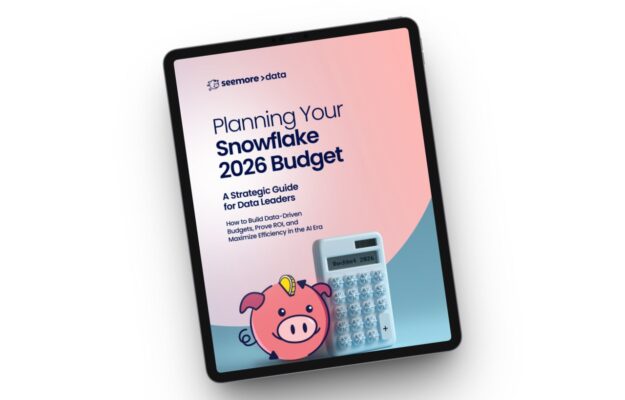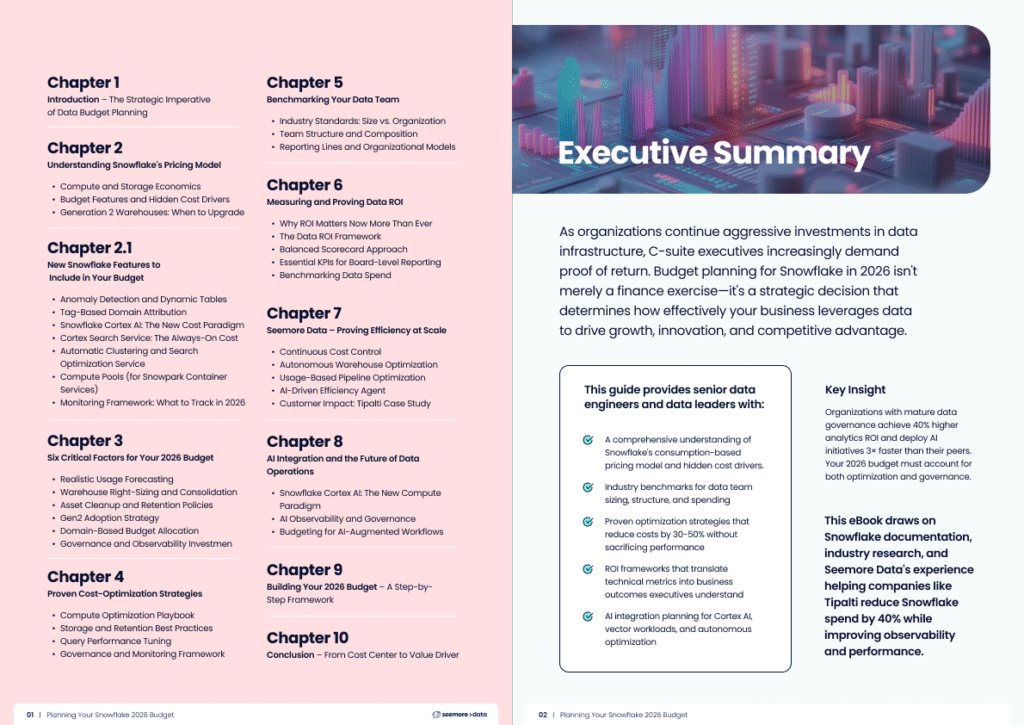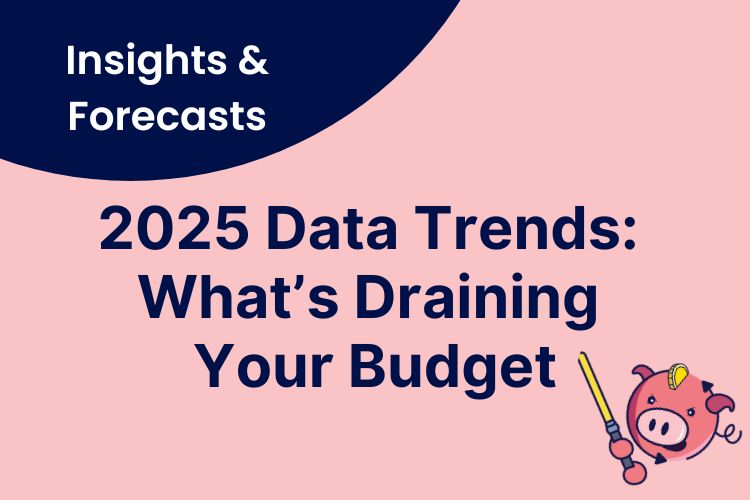Planning Your 2026 Snowflake Budget: What CDOs Need to Know


Snowflake costs aren’t slowing down – and neither is your data footprint. As 2026 approaches, teams are being asked to deliver growth, support more workloads, and reduce cloud spend at the same time. If you’re responsible for budget planning, you’re likely feeling the squeeze.
That’s why we created a new in-depth guide on how to plan your 2026 Snowflake budget with confidence. Below is a teaser of what’s inside – the key trends, blind spots, and strategic moves every data leader should know – before finalizing their numbers.
Why Snowflake Budgeting Gets Harder Every Year
Most teams underestimate next-year Snowflake spend by 25–40%. Not because they’re careless—because Snowflake usage grows in invisible ways:
- New dashboards are created but rarely sunset.
- Pipelines run more frequently than needed.
- Teams add new domains and data products with unclear ownership.
- Storage grows quietly and continually.
- Cost spikes occur with zero visibility into the root cause.
This creates a reactive budgeting model—one where you plan based on last year, then hope for the best. Our upcoming guide shows why this approach breaks down, and how proactive observability and attribution transform budgeting from guessing to forecasting.
3 Things Every 2026 Snowflake Budget Should Include
1. A Usage-Based View of Your Data Products
Most teams still budget at the warehouse or team level. But the real drivers of next year’s spend are individual data products.
The guide dives into how to evaluate:
- Query frequency
- Pipeline cost per run
- Orphaned assets
- High-cost dashboards
- SLA-driven compute requirements
This lets you align costs to business value instead of spreading them across teams.
2. Realistic Growth Curves (Not Just “+15% Over 2025”)
Snowflake growth rarely follows a flat multiplier.
A more accurate model considers:
- New operational workloads
- Increasing concurrency requirements
- Additional business domains
- AI and ML use cases that add compute in bursts
We break down actual growth patterns observed across companies using Snowflake and offer a framework to model them.
3. A Plan for Eliminating Hidden Waste Before 2026 Starts
The fastest ROI doesn’t come from negotiation—it comes from efficiency.
Teams that remove redundant pipelines, clean up abandoned dashboards, and rightsize warehouse usage before Q1 often reclaim 20–50% of their projected compute spend.
Our full guide outlines the exact audit checklist, including how to identify your biggest hidden inefficiencies using automated lineage and cost-attribution tools.
Why Budgeting Requires Full-Stack Visibility
You can’t plan a Snowflake budget without understanding the ecosystem around it: Fivetran, dbt, Airflow, BI tools, AI workloads, and custom ingestion frameworks.
Our research (and platform data) shows:
- 30–40% of Snowflake compute waste originates outside Snowflake—from upstream pipeline design or downstream dashboarding habits.
- Teams with no lineage visibility overspend by 20–35% because they can’t map cost to ownership.
- Forecasting requires cross-stack observability, not just Snowflake query logs.
This is why platforms like Seemore Data emphasize usage-based visibility across your entire data stack.
Where to Start: A 5-Minute Snapshot of 2026 Risk
While the full guide goes deep, here’s a quick framework from it:
Ask your team these six questions:
- What is the industry benchmark for high-performing data teams—team structure, composition, headcount, and data-to-engineer ratio?
- How can we quantify and communicate data ROI across products, domains, and business outcomes?
- What does a continuous cost-control model look like for our data stack, and where are the biggest opportunities to prevent waste?
- How do we ensure our AI workloads are efficient- cost-aware, scalable, and aligned with real business value?
- How can we fully leverage Snowflake’s advanced capabilities-Gen2, intelligent warehouse autoscaling, and right-sizing—to reduce spend without hurting performance?
- What SLAs should the business adopt to balance reliability, performance tuning, and cost efficiency across Snowflake workloads?
If the answer to at least two is “not sure,” your 2026 Snowflake budget is likely misaligned.
Ready to Build a Confident, Predictable 2026 Snowflake Budget?
The decisions you make over the next few months will shape your entire data strategy for 2026 – cost efficiency, team velocity, AI readiness, and your ability to scale without surprises. With the right visibility and the right forecasting model, Snowflake budgeting becomes less of a guessing game and more of a strategic advantage.
If you’re looking to benchmark your team, quantify data ROI, build continuous cost control, and fully leverage Snowflake’s advanced capabilities, our full guide goes much deeper.
It’s built for CDOs, Heads of Data, and engineering leaders who want clarity—not spreadsheets and guesswork.
Download the full guide and get the complete framework →
Or, if you’d rather see exactly where your Snowflake spend is headed, book a call with one of our Snowflake data experts.







